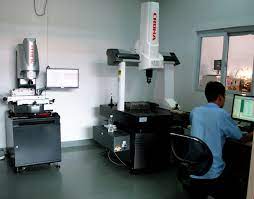Quality control is a critical aspect of CNC (Computer Numerical Control) machining to ensure that the produced parts meet the desired specifications and standards. Here’s what you need to know about quality control for CNC machining:
- Inspection Equipment:
- High-precision measuring tools like calipers, micrometers, gauges, and coordinate measuring machines (CMMs) are essential for accurate measurements.
- Optical comparators and surface finish testers help assess surface quality.
- First Article Inspection (FAI):
- Conduct an FAI for the first part of a production run to verify that the machine settings and programming are correct.
- Compare the FAI measurements to the engineering drawings to confirm compliance.
- In-Process Inspection:
- Regularly inspect parts during machining to catch any deviations early in the process.
- Monitor tool wear and replace cutting tools when necessary to maintain accuracy.
- Dimensional Accuracy:
- Ensure that parts meet dimensional tolerances specified in the engineering drawings.
- Verify features such as hole sizes, diameters, and angles.
- Surface Finish:
- Assess the surface finish of machined parts to ensure they meet the required standards.
- Surface roughness testers or profilometers can measure the surface texture.
- Material Quality:
- Confirm the material used is the correct alloy, grade, or type specified in the design.
- Material testing methods like spectroscopy or hardness testing may be necessary.
- Visual Inspection:
- Inspect parts for visual defects such as burrs, scratches, or irregularities.
- Use visual aids like microscopes or magnifying glasses for detailed examination.
- Tolerance Analysis:
- Perform a tolerance stack-up analysis to account for cumulative errors in assemblies.
- Ensure that parts fit together within the specified tolerances.
- Documentation:
- Maintain detailed records of inspection results, including measurements, timestamps, and inspector information.
- This documentation helps identify trends and facilitates corrective actions if necessary.
- Statistical Process Control (SPC):
- Implement SPC techniques to monitor and control the machining process.
- Use control charts and statistical analysis to identify variations and make necessary adjustments.
- Quality Management System (QMS):
- Adopt a QMS, such as ISO 9001, to ensure consistent quality control practices.
- Define quality control procedures and continuously improve them.
- Operator Training:
- Ensure that CNC machine operators are properly trained to operate the machines and conduct inspections.
- Training programs should cover machine operation, programming, and quality control.
- Corrective Action:
- Develop a system for addressing non-conforming parts.
- Implement corrective actions to prevent similar issues in the future.
- Preventive Maintenance:
- Regularly maintain CNC machines to prevent unexpected breakdowns or inaccuracies.
- A well-maintained machine is crucial for maintaining quality.
- Traceability:
- Establish a system for tracing parts back to their source, which is especially important in industries with strict quality and safety regulations.
Quality control in CNC machining is essential to ensure the production of accurate, reliable, and consistent parts. It helps maintain product quality, reduces waste, and enhances customer satisfaction while ensuring compliance with industry standards and specifications.
As a reliable CNC machining factory from China, Xielifeng Tech welcome all customers to customize all metal and plastic parts.

